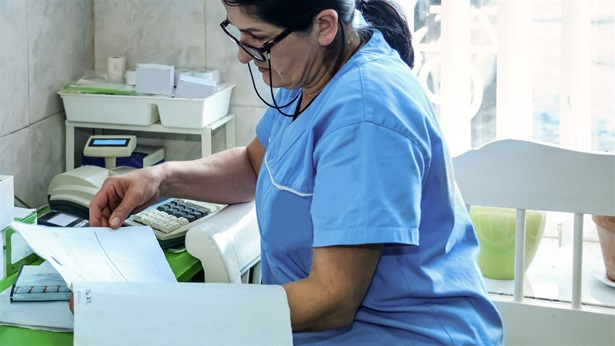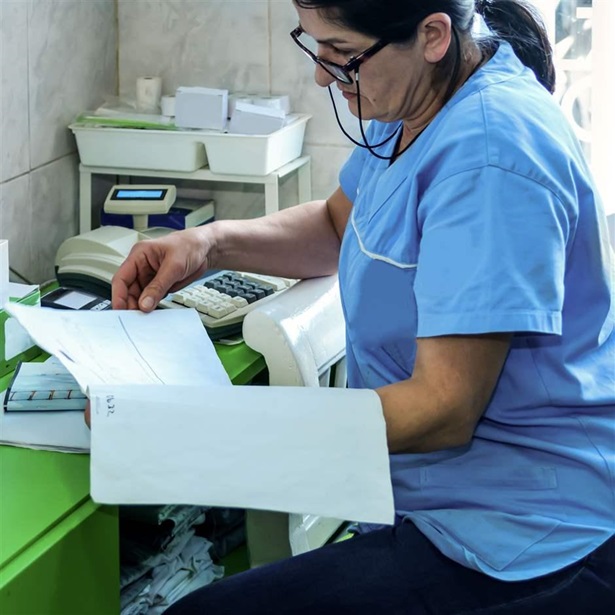How Medicaid Can Help Pregnant and Postpartum Persons With Opioid Use Disorder
Policymakers should leverage the program to fund needed care management and social supports

The misuse of opioids during pregnancy has more than doubled in the United States in recent years, jumping from 3.5 instances for every 1,000 delivery hospitalizations in 2010 to 8.2 in 2017.1 In addition, from 2018 to 2021 overdose death rates involving the most common psychotropic drugs increased for pregnant and postpartum people and more than tripled among 35- to 44-year-olds, with most of these deaths due to opioids.2
Opioid use during pregnancy has been linked to a variety of poor health outcomes for both mothers and babies such as maternal death, poor fetal growth, and preterm birth.3 Moreover, untreated opioid use disorder (OUD) among new parents is shown to impair their ability to care for a newborn.4
Medicaid is a powerful resource for delivering care to pregnant and postpartum patients with OUD, and also their babies; in 2021, the public insurance program paid for 41% of all U.S. births. State policymakers can yield improved outcomes and provide medical, behavioral health, and social supports for this population by maximizing Medicaid funding.5 Recently, The Pew Charitable Trusts and the Center on Health Care Strategies released State Principles for Financing Substance Use Care, Treatment, and Support Services, which include maximizing Medicaid for postpartum and other patients.6
Pregnancy/Postpartum Risks Associated With OUD
- Prolonged hospital stays for birthing parents
- Increased risk of pregnancy-related death during hospitalization
- Heightened risk of preterm births
- High risk of overdose seven to 12 months after delivery
- Increase in child welfare cases attributable to opioid misuse
Benefits of Medications for OUD (MOUD)
- Helps prevent relapse during pregnancy
- MOUD treatment during pregnancy yields better outcomes in infant birth weight and full-term delivery
- Parents who stay on MOUD are more likely to retain custody of their children
Sources: D.J. Corsi et al., “Association of Maternal Opioid Use in Pregnancy With Adverse Perinatal Outcomes in Ontario, Canada, from 2012 to 2018” (2020); D.M. Crowley et al., “Considering the Child Welfare System Burden From Opioid Misuse: Research Priorities for Estimating Public Costs” (2019); D.M. Schiff et al., “Fatal and Nonfatal Overdose Among Pregnant and Postpartum Women in Massachusetts” (2018); L. Radel et al., “Medication-Assisted Treatment for Opioid Use Disorder in the Child Welfare Context: Challenges and Opportunities” (2018); V.E. Whiteman et al., “Maternal Opioid Drug Use During Pregnancy and Its Impact on Perinatal Morbidity, Mortality, and the Costs of Medical Care in the United States” (2014); H.E. Jones, L.P. Finnegan, and K. Kaltenbach, “Methadone and Buprenorphine for the Management of Opioid Dependence in Pregnancy” (2012); Substance Abuse and Mental Health Services Administration, “Medications to Treat Opioid Use Disorder During Pregnancy”
The recommended clinical practice for pregnant patients with OUD includes medications for OUD (MOUD), specifically methadone and buprenorphine, as well as behavioral therapy and medical care.7 Yet a range of barriers exist to treatment and helpful social supports such as case management and family services, including:
- Inadequate health insurance coverage.
- Societal stigma surrounding OUD as well as medication treatment.
- Lack of stable and affordable housing.
- Poor access to specialty medical providers.
- Fear of seeking treatment because of the criminalization of opioid use and subsequent threat to child custody.8
Treatment approaches that combine MOUD with a range of social supports have been shown to improve outcomes for pregnant and postpartum clients as well as their infants. Social supports often include case management during treatment and recovery, education on how to care for opioid-exposed newborns, and family services such as instruction on child care and parenting.9
Case management is considered the glue that facilitates patients’ access to needed medical, social, educational, and other services.10 Such management can include creating a multiservice care plan (e.g., housing, child welfare, legal system, employment) that connects patients to providers in other service systems for ongoing support and that tracks patient adherence to treatment plans and monitors patient outcomes.
The Role of Medicaid
The Centers for Medicare and Medicaid Services (CMS) has provided states the flexibility to extend Medicaid coverage for postpartum patients. Policymakers can use Medicaid state plan amendments and waivers to fund many support services that have been found to improve outcomes for patients with OUD who are pregnant and parenting, and their infants.11
Extend Medicaid Eligibility
Federal law requires that Medicaid programs provide 60 days of postpartum coverage. However, in 2021 Congress passed the American Rescue Plan Act, which provided states the option to extend coverage for up to one year.12 Medicaid’s 60-day cutoff leaves many beneficiaries vulnerable because according to the U.S. Centers for Disease Control, more than half of pregnancy-related deaths occur up to one year after delivery, and most of those deaths are preventable.13 As of September 2023, 37 states and the District of Columbia have approved state plans for postpartum Medicaid coverage extensions. Although this one-year option was originally set to expire after five years, it was made permanent through the Consolidated Act of 2023, enacted in December 2022.14
State Plan Amendments
States submit formal plans to CMS for approval that include any optional benefits they choose to cover.
Some examples of optional services that can enhance care for pregnant and parenting patients with OUD are listed below. States can add these services to their existing plans via submitted state plan amendments.15
- Rehabilitation Services cover a variety of services for mental health and substance use disorders that focus on recovery, including independent living skills, relapse prevention, and job preparedness.16
- Targeted Case Management allows Medicaid to cover the case management services programs connecting this population to multiple service systems.17
- Health homes are intended for beneficiaries with chronic conditions and/or serious mental illness—they allow Medicaid to pay for comprehensive care management systems that include care coordination, patient and family support, and referral to social support services.18 States receive a 90% federal match rate for the first two years of the program. A number of states—including Maine, Maryland, Michigan, Rhode Island, Vermont, and Wisconsin—have used the health home option to develop opioid health homes.19
- SUPPORT Act Residential Pediatric Recovery Centers Provision contains a broad array of programs and policy reforms aimed at increasing access to OUD treatment. Also known as The 2018 Substance Use-Disorder Prevention that Promotes Opioid Recovery and Treatment for Patients and Communities Act, it adds an optional Medicaid provider type of “residential pediatric recovery center” to treat substance-exposed infants.20 Through this new provider type, states can use Medicaid to reimburse for care provided to substance-exposed infants as well as their parent/caretaker. The recovery centers serve as a temporary placement from the neonatal intensive care unit or hospital, prior to going home.
Medicaid Waivers
Waivers are time-limited arrangements that provide flexibility to state plans. They can be used to offer a particular group of enrollees specialized benefits, restrict enrollees to a specific provider network, or extend coverage to groups beyond those typically allowed by Medicaid.21
- 1915 (b), a Medicaid managed care waiver, allows states to deliver care through managed care and potentially limit provider network(s) based on recipients’ needs.
- 1915 (c), a home and community-based services (HCBS) waiver, allows a group of recipients to receive services at home or in the community to avoid institutionalization. This waiver can be used to offer substance use services to Medicaid patients with co-occurring mental disorders. Services can include day services, nonmedical transportation, supported employment, and other behavioral health services. An HCBS waiver can be limited to a certain population and be capped in terms of budget and participation.
- 1115, a research and demonstration waiver, provides states the freedom to pilot and test policy changes such as expanded eligibility, types of services, and innovative delivery systems. States that elect not to extend Medicaid coverage to pregnant people up to one year postpartum could use this waiver to provide a range of services to enrollees with OUD who would otherwise have lost coverage after 60 days postpartum because they exceeded income eligibility limits. As of August 2023, 13 states have applied (and 10 states have been approved) for section 1115 waivers to extend postpartum coverage.22
Promising Practices
Initiatives that provide patients with OUD who are pregnant or postpartum with a range of medical, mental health, and social services are showing promising results. Below are some examples, as well as how states could use Medicaid to fund them:
Moms in Recovery
New Hampshire’s Moms in Recovery, a program at Dartmouth-Hitchcock Medical Center, offers intensive treatment that includes MOUD, screening for the social drivers of health that connect families to needed services, group and individual counseling, recovery coaching, parenting classes, and case management.23 The program provides support for months, and sometimes years, after a patient’s child is born, with services covered through Medicaid expansion. A recent research brief found that newborns who had required treatment for opioid exposure had fewer in-hospital days as compared with those from families not participating in the program.24
States could use a range of Medicaid approaches to fund such an initiative. For instance, states with Medicaid managed care waivers can direct organizations that receive managed care contracts to offer increased payment rates to support these services. Creating a health home through a state plan amendment is another option for funding this program’s care coordination and other nonmedical services. An 1115 waiver would accomplish the same goal, albeit for a time-limited period. In addition, the targeted case management option could also be used to fund care coordination.
The Children and Recovering Mothers (CHARM) Collaborative
Developed in Vermont, CHARM uses a multidisciplinary team to coordinate care for patients with OUD during pregnancy and post-delivery.25 The program provides early prenatal care, connection to MOUD and mental health treatment, and social supports that include transportation and establishing a trusting relationship with child welfare services. A program evaluation found that patients who received CHARM services had babies with higher birth weights and were more likely to retain custody of their infants than patients who received MOUD only.26 Although CHARM is not currently using Medicaid to fund care coordination or other social supports, states could use the same mechanisms described for the Maternal Opioid Misuse (MOM) program below to support CHARM.
Centers for Medicare and Medicaid Services Maternal Opioid Misuse Demonstration
In 2019, CMS awarded five-year grants to 10 states so they could implement the MOM program for pregnant and postpartum Medicaid patients with OUD. State Medicaid agencies partnered with providers to deliver integrated medical, behavioral health, and wraparound services from pregnancy through postpartum care.27 The MOM grants supplemented Medicaid benefits by helping to fund treatment program infrastructure (e.g., hiring and training staff) as well as wraparound coordination and referral to needed social services.28 Maine used a state plan amendment to fund its health home model to provide MOM services to pregnant persons with OUD.29 Maryland used an 1115 demonstration waiver to finance components of its MOM model.30
Conclusion
Comprehensive programs that link pregnant people with OUD to medications, counseling, and a range of helpful wraparound social services have been found to keep parents in treatment longer and improve infant outcomes. States can use Medicaid to pay for many of these services.
Endnotes
- A.H. Hirai et al., “Neonatal Abstinence Syndrome and Maternal Opioid-Related Diagnoses in the U.S., 2010-2017,” JAMA 325, no. 2 (2021): 146-55, https://doi.org/10.1001/jama.2020.24991.
- B. Han et al., “Pregnancy and Postpartum Drug Overdose Deaths in the U.S. Before and During the COVID-19 Pandemic,” JAMA Psychiatry (2023), https://doi.org/10.1001/jamapsychiatry.2023.4523; J. Song, press officer, National Institute on Drug Abuse, National Institutes of Health, email to Jane Koppleman, senior officer, substance use prevention and treatment initiative, The Pew Charitable Trusts, Nov. 27, 2023.
- Centers for Disease Control and Prevention, “About Opioid Use During Pregnancy ” last modified Nov. 28, 2022, https://www.cdc.gov/pregnancy/opioids/basics.html.
- L. Radel et al., “Medication-Assisted Treatment for Opioid Use Disorder in the Child Welfare Context: Challenges and Opportunities” (Office of the Assistant Secretary for Planning and Evaluation, 2018), https://aspe.hhs.gov/sites/default/files/migrated_legacy_files/185086/MATChildWelfare.pdf.
- National Center for Health Statistics, “Birth Data,” Centers for Disease Control and Prevention, last modified Nov. 8, 2023, https://www.cdc.gov/nchs/nvss/births.htm.
- Center for Health Care Strategies, “State Principles for Financing Substance Use Care, Treatment, and Support Services” (2023), https://www.chcs.org/resource/state-principles-for-financing-substance-use-care-treatment-and-support-services/.
- Centers for Disease Control and Prevention, “Treatment for Opioid Use Disorder Before, During, and After Pregnancy,” last modified Nov. 15, 2022, https://www.cdc.gov/pregnancy/opioids/treatment.html.
- R. Stone, “Pregnant Women and Substance Use: Fear, Stigma, and Barriers to Care,” Health & Justice 3 (2015): 2, https://www.ncbi.nlm.nih.gov/pmc/articles/PMC5151516/.
- National Center on Substance Abuse and Child Welfare, “A Collaborative Approach to the Treatment of Pregnant Women With Opioid Use Disorders” (2016), https://store.samhsa.gov/product/A-Collaborative-Approach-to-the-Treatment-of-Pregnant-Women-with-Opioid-Use-Disorders/SMA16-4978.
- Substance Abuse and Mental Health Services Administration, “Comprehensive Case Management for Substance Use Disorder Treatment” (2021), https://store.samhsa.gov/product/advisory-comprehensive-case-management-substance-use-disorder-treatment/pep20-02-02-013.
- National Center on Substance Abuse and Child Welfare, “A Collaborative Approach.”
- U.S. Department of Health and Human Services, “Thousands More People With Medicaid and CHIP Coverage Now Eligible to Access Critical Postpartum Coverage Thanks to the American Rescue Plan,” news release, April 1, 2022, https://www.hhs.gov/about/news/2022/04/01/thousands-more-people-with-medicaid-and-chip-coverage-now-eligible-to-access-critical-postpartum-coverage-thanks-to-the-american-rescue-plan.html.
- Centers for Disease Control and Prevention, “Four in 5 Pregnancy-Related Deaths in the U.S. Are Preventable,” news release, Sept. 19, 2022, https://www.cdc.gov/media/releases/2022/p0919-pregnancy-related-deaths.html.
- Kaiser Family Foundation, “Medicaid Postpartum Coverage Extension Tracker,” news release, Nov. 14, 2023, https://www.kff.org/medicaid/issue-brief/medicaid-postpartum-coverage-extension-tracker/.
- Centers for Medicare and Medicaid Services, “Medicaid State Plan Amendments,” https://www.medicaid.gov/medicaid-state-plan-amendments/index.html.
- J.S. Crowley and M. O’Malley, “Medicaid’s Rehabilitation Services Option: Overview and Current Policy Issues” (Kaiser Family Foundation, 2007), https://www.kff.org/wp-content/uploads/2013/01/7682.pdf.
- Department of Health and Human Services, Medicaid Program; Optional State Plan Case Management Services, 0938-AO50 (2006), https://www.federalregister.gov/documents/2007/12/04/07-5903/medicaid-program-optional-state-plan-case-management-services.
- Centers for Medicare and Medicaid Services, “Health Home Information Resource Center,” https://www.medicaid.gov/resources-for-states/medicaid-state-technical-assistance/health-home-information-resource-center/index.html.
- Centers for Medicare and Medicaid Services, “State-by-State Health Home State Plan Amendment Matrix” (2022), https://www.medicaid.gov/state-resource-center/medicaid-state-technical-assistance/health-home-information-resource-center/downloads/state-hh-spa-at-a-glance-matrix-09-2022.pdf.
- C. Lynch, “CMCS Informational Bulletin” (Center for Medicaid and CHIP Services, 2019), https://www.medicaid.gov/federal-policy-guidance/downloads/cib072619-1007.pdf; Substance Use–Disorder Prevention that Promotes Opioid Recovery and Treatment for Patients and Communities Act, H.R. 6, House of Representatives (2018), https://docs.house.gov/billsthisweek/20180924/HR6.pdf.
- Medicaid and CHIP Payment and Access Commission, “Waivers,” https://www.macpac.gov/medicaid-101/waivers/.
- Kaiser Family Foundation, “Medicaid Waiver Tracker: Approved and Pending Section 1115 Waivers by State,” news release, Oct. 26, 2023, https://www.kff.org/medicaid/issue-brief/medicaid-waiver-tracker-approved-and-pending-section-1115-waivers-by-state/.
- Dartmouth Hitchcock Medical Center and Dartmouth Hitchcock Clinics, “Moms in Recovery,” https://www.dartmouth-hitchcock.org/moms-recovery.
- K. Smith, “As Opioid Use Climbs, Neonatal Abstinence Syndrome Rises in New Hampshire,” University of New Hampshire Carsey School of Public Policy, Dec. 19, 2017, https://carsey.unh.edu/publication/opioid-nas-nh.
- Substance Abuse and Mental Health Services Administration, “The Children and Recovering Mothers (CHARM) Collaborative in Burlington, Vermont: A Case Study” (2014), https://www.opioidlibrary.org/wp-content/uploads/2019/08/CHARM_CaseStudy_Draft_080614.pdf.
- M. Meyer et al., “Development of a Substance Abuse Program for Opioid-Dependent Nonurban Pregnant Women Improves Outcome,” J Addict Med 6, no. 2 (2012): 124-30.
- Centers for Medicare and Medicaid Services, “Maternal Opioid Misuse (MOM) Model,” https://www.cms.gov/priorities/innovation/innovation-models/maternal-opioid-misuse-model.
- Ibid.
- Centers for Medicare and Medicaid Services, “Medicaid State Plan Amendments.”
- Maryland Department of Health, “Federal Government Signs Off on Maryland Medicaid’s 1115 Waiver Renewal,” Jan. 6, 2022, https://health.maryland.gov/newsroom/Pages/Federal-government-signs-off-on-Maryland-Medicaid%E2%80%99s-1115-waiver-renewal.aspx.















